题目内容
When you write a text message or an email, you might put a smiling face or other pictures at the end to make the message more fun. These pictures are emojis. The first emojis were on Japanese mobile phones in the 1990s. Later, they were used on Apple’s iPhone and Android phones. Now they are everywhere!
Before emojis, there were emoticons. The word is a mixture(混合) of emotion(感情) and icon(图标). Emoticons are made of the signs you can find on your keyboard, for example:-) for a smiley or @};---for a rose. The first use of :-)was in 1982 and it was called “joke marker”. Emoji is a Japanese word which means pictograph: e(picture) +moji (character). Emojis are real pictures, for example ,or
,or .There are 1851emojis that can be used on mobile phones and other devices. There are all kinds of emojis, from faces and weather to things in the kitchen and animal.
.There are 1851emojis that can be used on mobile phones and other devices. There are all kinds of emojis, from faces and weather to things in the kitchen and animal.
In England, we have a saying: A picture paints a thousand words. For many people, an emoji is like a punctuation mark(标点). It’s like the tone of voice when we speak on the phone, or hand movements(gestures) used in conversation. Emojis are also changing the way we write. The more we use emojis, the less we use slang(俚语), such as LOL or OMG.
When someone speaks and looks serious, we try to look serious, too, and when someone smiles, we smile as well. This is how we show empathy(同感) and make friends(and enemies!). But when we’re online, we can’t see the person’s face and there’s no emotion. The invention of emojis changed that! Scientists in Australia have discovered that when we look at a smiley face online, the same parts of the brain start working as when we look at a real smiley face. Our mood changes, and we try to change our face to match the emoji. This is something we learn as we get older. Our brains have developed this ability over the last two or three years. This means that emojis have created a new brain pattern(模式)in us!
1.Where does the writer of this passage possibly come from?
A.Australia B.Japanese C.America D.Britain
2.What is NOT true about Paragraph 3?
A.Some slang is used less often because of emojis.
B.We no more need words.
C.An Emoji adds emotions to our messages.
D.An Emoji makes people feel face to face.
3.What is (= ̄ω ̄=) according to the passage?
A.an emoji B.a picture C.an emoticon D.a sound
4.What can we learn from the passage?
A.Emojis will make our words disappear.
B.Emojis have greatly influenced us in many ways.
C.We don’t need to speak to others or meet others any more.
D.Scientists are worried about this invention of emojis.


